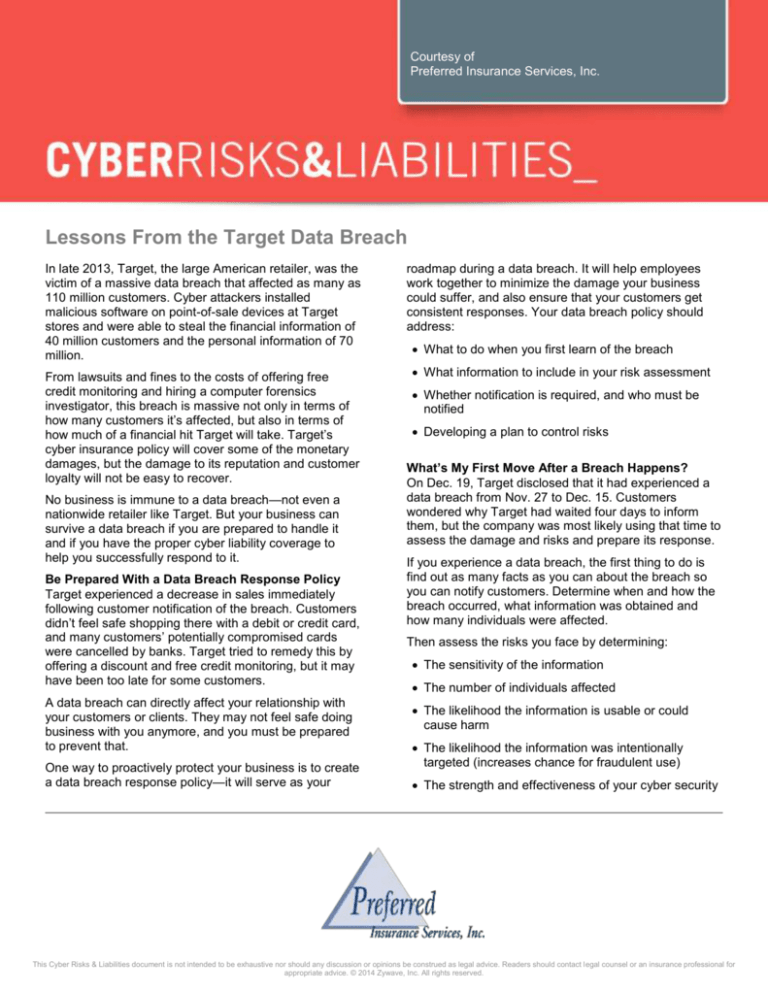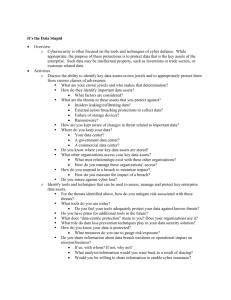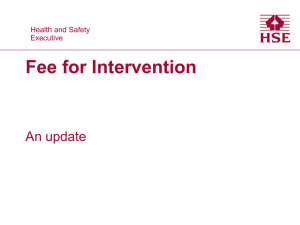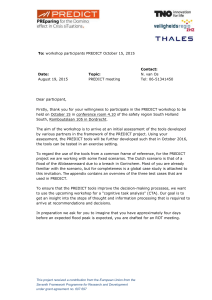
Courtesy of
Preferred Insurance Services, Inc.
Lessons From the Target Data Breach
In late 2013, Target, the large American retailer, was the
victim of a massive data breach that affected as many as
110 million customers. Cyber attackers installed
malicious software on point-of-sale devices at Target
stores and were able to steal the financial information of
40 million customers and the personal information of 70
million.
From lawsuits and fines to the costs of offering free
credit monitoring and hiring a computer forensics
investigator, this breach is massive not only in terms of
how many customers it’s affected, but also in terms of
how much of a financial hit Target will take. Target’s
cyber insurance policy will cover some of the monetary
damages, but the damage to its reputation and customer
loyalty will not be easy to recover.
No business is immune to a data breach—not even a
nationwide retailer like Target. But your business can
survive a data breach if you are prepared to handle it
and if you have the proper cyber liability coverage to
help you successfully respond to it.
Be Prepared With a Data Breach Response Policy
Target experienced a decrease in sales immediately
following customer notification of the breach. Customers
didn’t feel safe shopping there with a debit or credit card,
and many customers’ potentially compromised cards
were cancelled by banks. Target tried to remedy this by
offering a discount and free credit monitoring, but it may
have been too late for some customers.
A data breach can directly affect your relationship with
your customers or clients. They may not feel safe doing
business with you anymore, and you must be prepared
to prevent that.
One way to proactively protect your business is to create
a data breach response policy—it will serve as your
roadmap during a data breach. It will help employees
work together to minimize the damage your business
could suffer, and also ensure that your customers get
consistent responses. Your data breach policy should
address:
What to do when you first learn of the breach
What information to include in your risk assessment
Whether notification is required, and who must be
notified
Developing a plan to control risks
What’s My First Move After a Breach Happens?
On Dec. 19, Target disclosed that it had experienced a
data breach from Nov. 27 to Dec. 15. Customers
wondered why Target had waited four days to inform
them, but the company was most likely using that time to
assess the damage and risks and prepare its response.
If you experience a data breach, the first thing to do is
find out as many facts as you can about the breach so
you can notify customers. Determine when and how the
breach occurred, what information was obtained and
how many individuals were affected.
Then assess the risks you face by determining:
The sensitivity of the information
The number of individuals affected
The likelihood the information is usable or could
cause harm
The likelihood the information was intentionally
targeted (increases chance for fraudulent use)
The strength and effectiveness of your cyber security
This Cyber Risks & Liabilities document is not intended to be exhaustive nor should any discussion or opinions be construed as legal advice. Readers should contact legal counsel or an insurance professional for
appropriate advice. © 2014 Zywave, Inc. All rights reserved.
By fully analyzing the data breach, the information you
give to your customers or clients is as accurate as
possible and will hopefully ease their worries. And if the
information is coming directly from you, your customers
may feel confident that you have control of the situation.
Solid Customer Notification Is Key
Customers criticized Target for not responding to the
data breach right away. When Target finally did say
something about it, customers saw the response as
unapologetic and too formal.
The way a company responds to a data breach can build
or damage the trust and loyalty of customers. Tailor the
response to your audience. Be understanding of how
your customers or clients feel, because you probably
feel the same way—you are both victims of the breach.
Improve Your Cyber Security Protocols
Soon after the breach, Target announced to customers
that it had invested in internal processes and systems to
reduce the chances of a data breach happening again. It
also said it was working with a computer forensics firm to
investigate the breach in hopes that it could determine
the cause and repair it.
Every company has data to protect, whether it’s client or
customer data, employee data or other company
information. Data breaches can be devastating if you
lack effective security protocols. Encrypting your
sensitive data, using role-based monitoring to detect
suspicious insider activity and adopting the National
Security Administration’s “two-person rule” are actions
you can take to strengthen your protection.
Regularly review your security protocols to ensure your
data is adequately protected. Keep in mind that as
technology evolves, cyber criminals evolve, too, and
their attacks become even more sophisticated and
targeted.
Possible Impact on Your Company’s Leadership
Five months after disclosing its data breach, Target
faced big changes in its executive leadership—CEO
Gregg Steinhafel left the company after 35 years, seven
of which he had served as CEO. Steinhafel’s departure
came shortly after Target’s Chief Information Officer,
Beth Jacob, stepped down from her position.
After the breach, Target struggled to regain customer
loyalty, which negatively impacted sales as well as the
price of its shares. Target’s board was plagued with
questions about whether it had responded quickly
enough to the breach, further damaging the company’s
reputation.
Target’s story shows that the aftereffects of a data
breach impact more than just your cyber security
measures. Your company’s leadership may change,
either voluntarily or out of necessity, so you must be
ready to react.
Protect Your Business With Cyber Liability Coverage
Notifying customers, setting up a call center dedicated to
breach-related calls and providing free credit monitoring
are a few ways Target responded to the data breach.
These actions are costly, but fortunately for business
owners, cyber liability coverage can help defray some of
those costs.
Every company is a potential target for cyber criminals.
Don’t think of a data breach as a possibility but as an
expectation, and always be prepared to respond.
Contact Preferred Insurance Services, Inc. today for
more information on data breaches and to learn about
the cyber liability coverage options for your business.







